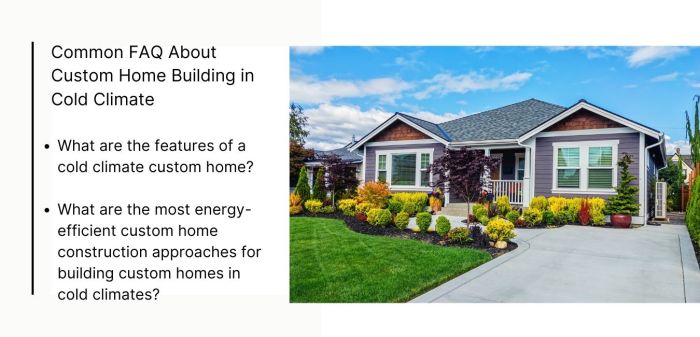Northern Home Improvement Design Trends for Cold Climates introduces readers to the unique challenges of designing homes in cold climates. From insulation to material selection, this topic delves into the essentials of creating cozy and efficient living spaces in chilly environments.
Exploring popular architectural styles and interior design considerations, this discussion offers a comprehensive look at enhancing comfort and aesthetics in cold climate homes.
Overview of Northern Home Improvement Design Trends for Cold Climates
Designing homes in cold climates presents unique challenges that require careful consideration and planning. The harsh weather conditions, including extreme cold temperatures and heavy snowfall, necessitate specific design elements to ensure homes are comfortable, energy-efficient, and durable.
Insulation is a key factor in cold climate home design, helping to retain heat and reduce energy costs. Proper insulation in walls, roofs, and floors is essential to maintain a consistent indoor temperature and prevent heat loss.
Energy efficiency is another crucial aspect of designing homes in cold climates. High-performance windows, doors, and HVAC systems can help reduce energy consumption and lower heating bills, while also minimizing environmental impact.
Choosing materials that are suitable for cold weather is essential to ensure the longevity and durability of the home. Materials such as brick, stone, and wood are commonly used in cold climate home construction for their ability to withstand harsh weather conditions.
Popular Architectural Styles and Design Elements
- Scandinavian Design: Known for its minimalistic and functional approach, Scandinavian design emphasizes natural light, clean lines, and a connection to nature. This style often incorporates light-colored wood, neutral tones, and cozy textiles to create a warm and inviting atmosphere.
- Log Cabins: A classic choice for cold climates, log cabins are known for their rustic charm and natural beauty. These homes are typically constructed from logs with airtight seals to provide excellent insulation and energy efficiency.
- Modern Chalets: Combining contemporary design with traditional alpine elements, modern chalets feature large windows, open floor plans, and high ceilings to maximize natural light and showcase scenic views. These homes often incorporate natural materials like wood and stone for a cozy yet sophisticated look.
Insulation and Energy Efficiency

Proper insulation is crucial in cold climate homes to ensure comfort, reduce energy costs, and minimize heat loss.
Types of Insulation Materials
- Fiberglass: A common and cost-effective choice that comes in batts, rolls, or loose fill.
- Cellulose: Made from recycled paper and treated to be fire-resistant, ideal for attics and walls.
- Spray Foam: Provides a tight seal and high R-value, great for sealing gaps and spaces.
- Rigid Foam: Offers high insulation value and moisture resistance, suitable for foundations and roofs.
Improving Energy Efficiency
Design elements such as windows, doors, and roofing can significantly impact energy efficiency in cold climates.
- Windows: Opt for double or triple-pane windows with low-E coatings to reduce heat transfer.
- Doors: Choose insulated doors with weather stripping to prevent drafts and heat loss.
- Roofing: Use reflective roofing materials to minimize heat absorption and reduce cooling needs in the summer.
Material Selection for Cold Climates

When it comes to home improvement in cold climates, choosing the right materials is crucial to ensure durability and weather resistance. By selecting materials that can withstand harsh winter conditions, homeowners can enhance the longevity and comfort of their homes.
Durable and Weather-Resistant Materials
In cold climates, materials like stone, brick, and metal are popular choices due to their ability to withstand extreme temperatures and moisture. Stone, such as granite or limestone, is known for its durability and natural beauty, making it a timeless option for exterior finishes.
Brick is another resilient material that provides excellent insulation and can withstand freezing temperatures without deteriorating. Metal, such as steel or aluminum, is often used for roofing and siding due to its longevity and resistance to corrosion.
Innovative Materials for Cold Weather
Advancements in technology have led to the development of innovative materials that offer both aesthetic appeal and functionality in cold climates. For example, fiber cement siding is a durable and low-maintenance alternative to traditional wood siding, providing excellent insulation and resistance to moisture.
Additionally, insulated concrete forms (ICFs) are becoming increasingly popular for their energy efficiency and ability to withstand harsh weather conditions while reducing heating costs.
Interior Design Considerations
When it comes to interior design in cold climate homes, creating a cozy and comfortable atmosphere is key. By choosing the right colors, textures, fabrics, and incorporating heating systems effectively, you can enhance the warmth of your living space during the colder seasons.
Color Palette and Textures
Choosing warm and inviting colors like deep reds, oranges, and earth tones can help create a cozy ambiance in your home. Pair these colors with rich textures like wool, faux fur, and plush fabrics to add depth and warmth to your space.
Furniture and Layout
Opt for upholstered furniture pieces with soft cushions and throws to make your living areas feel inviting and comfortable. Consider arranging furniture in a way that promotes conversation and coziness, such as creating a seating area around a fireplace or focal point.
Lighting and Ambiance
Soft, warm lighting can enhance the comfort of your home during cold weather. Use table lamps, floor lamps, and candles to create a cozy ambiance. Consider installing dimmer switches to adjust the lighting levels based on your mood and the time of day.
Heating Systems and Fireplaces
Incorporating efficient heating systems like radiant floor heating, ductless mini-split systems, or a high-efficiency furnace can help maintain a comfortable temperature indoors. Fireplaces, whether gas or wood-burning, not only provide warmth but also add a charming focal point to your space.
Landscape and Exterior Design
When it comes to designing the exterior of homes in cold climates, there are several key factors to consider in order to create a functional and aesthetically pleasing outdoor space.
Landscaping Trends for Cold Climates
- Choose native plants that are well-adapted to the cold climate, requiring less maintenance and watering.
- Incorporate evergreen trees and shrubs to provide year-round color and texture to your landscape.
- Create windbreaks with strategically placed trees and shrubs to help protect your home from harsh winter winds.
- Add elements like stone pathways, raised beds, and decorative boulders to enhance the visual appeal of your outdoor space.
Snow Management and Outdoor Lighting
- Invest in a reliable snow removal system, such as heated driveways or snow melting mats, to keep your outdoor spaces accessible during winter.
- Install outdoor lighting fixtures that are designed to withstand cold temperatures and snow accumulation, ensuring safety and visibility in the dark winter months.
- Consider adding decorative lighting elements like string lights or lanterns to create a cozy ambiance in your outdoor space during colder seasons.
Durable Outdoor Furniture for Cold Climates
- Opt for weather-resistant materials like teak, cedar, or metal when selecting outdoor furniture to withstand the harsh conditions of cold climates.
- Choose furniture pieces with high-quality cushions and upholstery that are designed to resist moisture and mold, ensuring durability and comfort in cold weather.
- Store outdoor furniture in a protected area or use covers during extreme winter months to extend their lifespan and maintain their appearance.
Creating Year-Round Outdoor Spaces
- Add features like fire pits, outdoor heaters, or hot tubs to create a warm and inviting outdoor space that can be enjoyed even in the colder months.
- Incorporate elements like pergolas, awnings, or retractable screens to provide shelter from wind and snow, allowing you to use your outdoor space throughout the year.
- Design outdoor dining areas with proper lighting, heating options, and wind protection to make al fresco dining possible in cold weather.
End of Discussion
In conclusion, Northern Home Improvement Design Trends for Cold Climates encapsulates the essence of creating functional and beautiful spaces that withstand the harsh winter elements. Whether it's landscaping tips or energy-efficient solutions, this guide equips homeowners with the knowledge to transform their homes into cozy winter retreats.
User Queries
What are the best materials for cold climate home improvement?
Materials like stone, brick, and metal offer durability and weather resistance, making them ideal choices for cold climates.
How can I enhance energy efficiency in my cold climate home?
Improving insulation and opting for energy-efficient design elements like windows and doors can significantly enhance energy efficiency.












